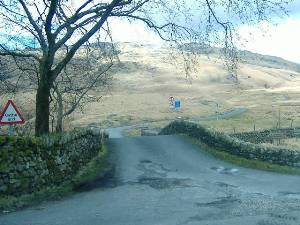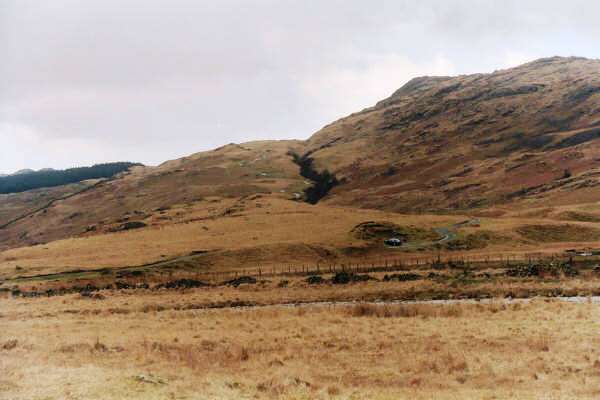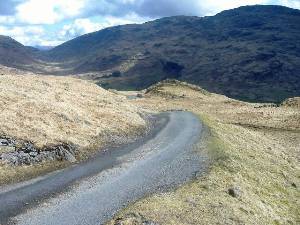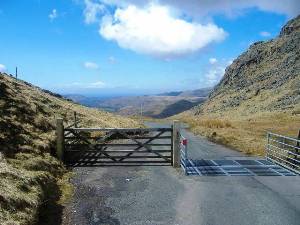The Hardknott Pass
The Big One


After following the River Duddon for a mile or so, we reach Cockley Beck, where a turning to the right takes us across Cockley Bridge, a small stone arched structure and onto the Hardknott Pass road. There are only three ways out from this bridge by road. The first is the way you've just come, the second is to continue alongside the River Duddon to the south-west, into Dunnerdale, eventually reaching the A595 at Duddon Bridge, and the third (my preference) is to cross the bridge and take the challenge of the Hardknott Pass.
The second picture is another of Nic Storr's - he also took the challenge of Hardknott. Look out for another set of warning signs ahead.

After passing another of those warning signs about steep hills and wintry conditions, which effectively ask, "Are you sure you want to go up here?", we begin the climb up Hardknott, which is unmistakably different from the relatively straight ascent up the Wrynose Pass. Here, the hairpins begin almost immediately, as we climb up what is reputedly the second steepest road in Britain. (If this isn't enough for you, try Rosedale Chimney in North Yorkshire). You need to keep a steady head if you are driving, but nevertheless, Hardknott is more than achievable in a family car in good dry conditions. The landscape is open grassland and the mountain sheep stare at the traffic, as if to ask what you are doing on their mountainside. It must be a strange existence for them.
Steven Jukes reports the occasion he was driving up the pass when he noticed a car in his mirrors, gaining rapidly on him. It was only when he was finally overtaken that he realised it was Colin McRae filming a Ford commercial.

Another of Nic's pictures here - looking back the way we came towards the Duddon Valley. The gap on the left hand side might be the Wrynose Pass, but I have to confess that I'm not certain about that.
The Hardknott Pass also reaches an altitude of 393m according to the spot height on the OS maps, but other sources suggest that at 1,291 feet, it is a full 10 feet higher than the Wrynose Pass. To be honest though, the relative height of each pass was not foremost in my mind when there. Far more impressive was the driving experience and the stunning views that unfolded in the area around the passes.

The road twists and turns as it negotiates its narrow course and steep gradients. It is worth stopping (where it is safe to do so) in order that the driver can gain full enjoyment of the more distant views experienced by any passengers - whilst the car is in motion, the driver will need to focus all their attention on the road immediately around him. Nothing about this drive is predictable. Nothing is neatly ordered - no two bends are the same. There is a certain camaraderie between motorists - there is plenty of give and take between opposing flows of traffic. Everyone there knows that in order to negotiate the road in a safe and enjoyable manner, you shouldn't rush, but be patient, enjoying the views whilst you wait for someone to pass by the other way.
I think this is my favourite of Nic's pictures - the colour of the sky, the cattle grid contrasting with the more distant hills below - fantastic. It is a quiet moment at the top of the pass. Presumably the cattle-grid is intended to keep the sheep on the right side of the pass?
Wrynose and Hardknott Pass - Introduction
The Route - Great Langdale
The Wrynose Pass
The Hardknott Pass
The Descent to Eskdale
Other Lakeland Passes
Copyright © 2004 - 2005 Simon Davies







